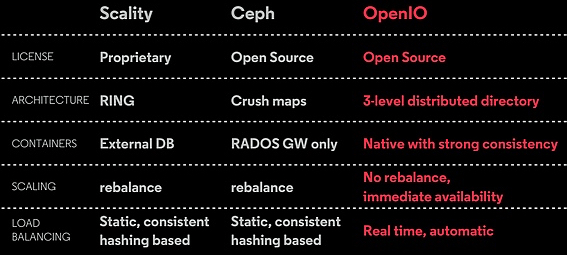Start-Up Profile: OpenIO
Another French one in open source object storage for massive data
By Jean Jacques Maleval | April 25, 2016 at 2:59 pmCompany
OpenIO SAS
Location
HQ in Hem, France, office in San Francisco, CA, also in Montreal, Canada and Tokyo, Japan
Date founded
June 2015
Financial funding
Capital of €240,000, self funded
Founders and main executives
The seven co-founders are experts in mail and data infrastructures:
![]() Laurent Denel, CEO, has been involved in a massive email platform for a major Telco in France. (44 million mailboxes, 8PB) ans was system engineer at Atos Worldline.
Laurent Denel, CEO, has been involved in a massive email platform for a major Telco in France. (44 million mailboxes, 8PB) ans was system engineer at Atos Worldline.
- George Lotigier, president, is president of Groupe Vade Retro/OpenIO/Scalair, CEO of Vade Retro Technology and president of Scalair.
- Marie Ponseel, COO
- Jean-François Smigielski, R&D manager
- Guillaume Delaporte, product manager
- Julien Kasarherou, ecosystem architect
- Romain Acciari, DevOps engineer
Advisors:
- Philippe Nicolas (Scality, Brocade, Symantec, Veritas Software, SGI)
- Reza Malekzadeh (Cumulus, Nimbula, Akimbi, Twingo, VMware)
Number of employees
16
Technology
Open source object storage software to store, protect, serve and process data at large scale
Products description
OpenIO has a long history as the first design took place in 2006 with first massive deployment in 2009 for a large scale email storage with 1PB at Orange and SFR. In 2012, a significant cluster was deployed with 650 nodes in production, an illustration of the scalability of the object storage technology promoted by OpenIO. The first production ready version was built in 2008 and the first massive production of a large scale email system started one year later. Since then, the solution has been used to store 10+PB, 10+ billions of objects, at 20Gb/s of bandwidth at the peak hour, with low-latency SLAs enforced 24/7. This object storage solution became Open Source in 2012. Today, OpenIO has the mission to support the open source community, and to make the solution widely available especially for the most demanding use cases.
OpenIO is a pure software-defined storage product and hardware agnostic. It is suited for small and large files and applications can access data via native APIs (available in Python, Go, C and Java), a command line interface, file-based access or applications-oriented connectors. Beyond enterprise file sharing protocols such NFS, SMB, AFP, FTP or FUSE delivered via the File Storage connector, OpenIO offers an Email connector for Cyrus, Zimbra, Dovecot and Openwave Messaging and a Video connector to sustain high demanding content service around adaptive streaming and event based transcoding.
OpenIO offers replication and erasure coding to protect data and topologies can varied with mono, multiple or geo/stretched cluster in one or multiple data centers.
Since the inception, OpenIO has made some design choice for the product:
- 1. Directory with indirections (three levels) facilitates transparent scalability and avoids the need to rebalance data every time the cluster topology changes like a consistent hashing based system does each tine.
- 2. Grid of nodes is based on a shared-nothing philosophy and scale-out by design with no single point of failures. Capacity and computing power are aggregated with resiliency in mind to provide a strong storage and processing platform.
- 3. Conscience provides the optimal data placement based on real-time score evaluation with health metrics collection for each grid’s services and nodes’ workload.
- 4. Grid for Apps is a mode where applications run within the cluster to leverage the compute power of the storage pool. The main idea is to run applications where data reside.
The start-up articulates its offering with the notion of editions tailored to vertical markets and IT needs:
- Open Source Core is the common piece among all packages as the foundation of the object storage service. The WebUI plus object SDKs and APIs such as OpenIO REST/HTTP, OpenStack Swift and Amazon S3 are provided with the associated standard service plan.
- Mail Edition is a solution dedicated to email services such Dovecot, Cyrus, Zimbra and Openwave Messaging.
- Video Edition is a new offering aligned with media and entertainment demanding environments to serve, protect, transcode and stream multimedia contents.
- Enterprise Storage Edition represents the enterprise object storage with classic file services capabilities with NFS, SMB, AFP, FTP built on top of the Open Source Core engine.
Release date
V15.12 in December 14, 2015
Prices
Core software is open source and standard support is available for production deployment. The standard support fee is at $0.08/consumed GB/year and offers as well Access Methods APIs (HTTP, Amazon S3 and OpenStack Swift) plus the WebUI.
For 700TB for 5 years, the standard package is $280,000 or $0.4/GB.
On top of that, customer may consider the application-aware connector such Mail, Video or just the file sharing needs. For each of these, a connector package is priced $30,000/year.
Additionally, some applications connectors could be added on the core engine for Email (Cyrus, Dovecot, Zimbra, Openwave Messaging and Mail object), File Storage or Video/Media service (HTTP, Adaptive streaming and Event based transcoding). Two other supports are available: Premium and Platinum.
Partners
HPE, Scalair, Outpace.io
Distributors and OEMs
None
Number of customers
Less than 10 customers but already 50 millions users for email storage via their telco deployments
Main customers
SFR/Numericable, Scalair, Aqua Ray
Applications
Email storage, large scale file repository, video rendering, active archive, converged infrastructure where applications run within the cluster.
Target market
Telco and enterprise with email storage, media and entertainment, life sciences, oil and gas and HPC.
Competitors
Amplidata/WDC/HGST, Caringo, Ceph, Cleversafe/IBM, Cloudian, DDN (WOS), Dell (with EMC offering), Minio, NetApp, Quantum, Scality, SwiftStack














 Subscribe to our free daily newsletter
Subscribe to our free daily newsletter

